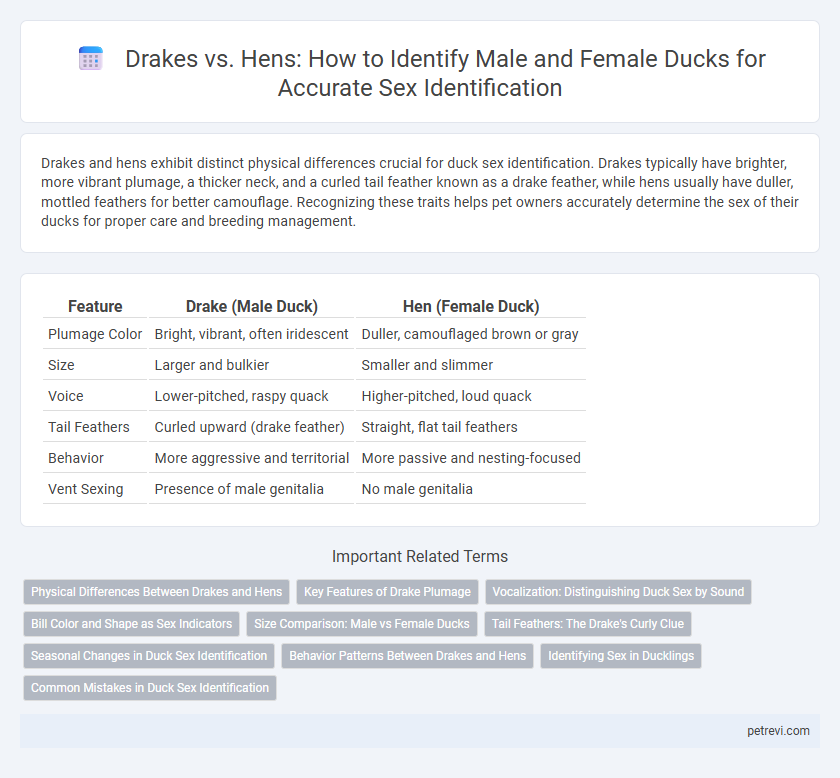Drakes and hens exhibit distinct physical differences crucial for duck sex identification. Drakes typically have brighter, more vibrant plumage, a thicker neck, and a curled tail feather known as a drake feather, while hens usually have duller, mottled feathers for better camouflage. Recognizing these traits helps pet owners accurately determine the sex of their ducks for proper care and breeding management.
Table of Comparison
| Feature | Drake (Male Duck) | Hen (Female Duck) |
|---|---|---|
| Plumage Color | Bright, vibrant, often iridescent | Duller, camouflaged brown or gray |
| Size | Larger and bulkier | Smaller and slimmer |
| Voice | Lower-pitched, raspy quack | Higher-pitched, loud quack |
| Tail Feathers | Curled upward (drake feather) | Straight, flat tail feathers |
| Behavior | More aggressive and territorial | More passive and nesting-focused |
| Vent Sexing | Presence of male genitalia | No male genitalia |
Physical Differences Between Drakes and Hens
Drakes typically exhibit brighter plumage with iridescent green or blue feathers on their heads, while hens have mottled brown feathers for better camouflage. The drake's tail feathers often curl upward, known as the "drake feather," absent in hens. Additionally, drakes possess a thicker, more pronounced neck and larger body size compared to hens, aiding in sex identification.
Key Features of Drake Plumage
Drake plumage is characterized by vibrant, iridescent colors with a glossy green head, often accompanied by a white neck ring and cobalt blue wing patches called speculums. In contrast, hens display mottled brown feathers designed for camouflage, lacking the bright coloration seen in drakes. Key features such as the curled tail feathers, known as drake feathers, and more pronounced vocalizations further aid in distinguishing male ducks from females.
Vocalization: Distinguishing Duck Sex by Sound
Drakes produce deeper, louder quacks with a more resonant tone, while hens emit higher-pitched, softer quacks that are often more repetitive. These vocal differences are due to variations in their syrinx muscles and vocal tract anatomy, allowing for accurate sex identification through sound. Observing vocal patterns during mating seasons provides reliable cues for distinguishing male and female ducks in the wild.
Bill Color and Shape as Sex Indicators
Drakes typically exhibit brighter, more vivid bill colors such as yellow or greenish hues, while hens often have duller, orange-brown shades. The shape of the bill in drakes is generally broader and more robust, helping to distinguish them from the narrower, more tapered bills of hens. Observing both color intensity and bill morphology provides reliable indicators for duck sex identification.
Size Comparison: Male vs Female Ducks
Male ducks, or drakes, generally exhibit larger body sizes and more robust builds compared to female ducks, or hens. Drakes often have broader heads and longer tails, with size differences becoming more noticeable as ducks mature. This size disparity aids in quick sex identification for species where plumage alone is insufficient.
Tail Feathers: The Drake's Curly Clue
Drakes can be identified by their distinctive tail feathers, known as the "curly clue," which curl upwards unlike the straight tail feathers of hens. This unique feature is most visible during the breeding season and helps quickly distinguish males from females. Observing the tail feather shape provides a reliable and semantically significant indicator for duck sex identification.
Seasonal Changes in Duck Sex Identification
Drakes exhibit more vibrant plumage during the breeding season, making sex identification easier compared to hens, which maintain more subdued coloring year-round. Seasonal molting causes drakes to shed their bright feathers post-breeding, resulting in eclipse plumage that closely resembles hens, complicating visual sex differentiation. Behavioral cues such as vocalizations and mating displays also assist in sex identification during peak breeding periods.
Behavior Patterns Between Drakes and Hens
Drakes exhibit more territorial behaviors, such as head bobbing and vocal quacking, especially during mating season, while hens tend to be more reserved and less aggressive. Drakes often display more pronounced courtship rituals, including wing flapping and tail shaking, which hens typically do not perform. Observing these distinct behavior patterns aids significantly in accurately identifying the sex of ducks in both wild and domestic environments.
Identifying Sex in Ducklings
Drake ducklings typically exhibit a larger, more robust body and a slightly thicker neck compared to hens, which helps in early sex identification. The presence of a small, developing cloacal protuberance, known as the "bump," is a reliable indicator of male ducklings, whereas female ducklings lack this feature. Observing feather patterns also aids identification, as drakes often develop brighter coloration sooner than ducklings.
Common Mistakes in Duck Sex Identification
Common mistakes in duck sex identification often arise from confusing drakes and hens due to similar plumage during juvenile stages. Many observers misinterpret the presence of curled tail feathers, which are definitive of drakes, and overlook subtle vocal differences such as the quieter quack of drakes compared to hens. Relying solely on size or color without considering behavioral cues frequently leads to incorrect sex determination in domestic and wild ducks.
Drakes vs Hens for Duck Sex Identification Infographic

 petrevi.com
petrevi.com